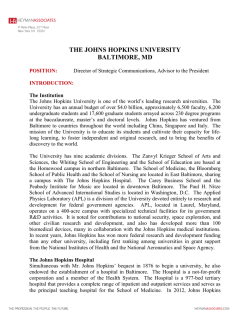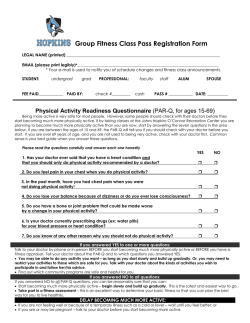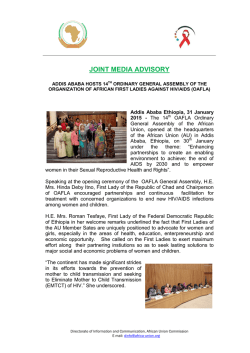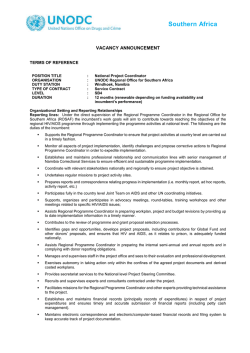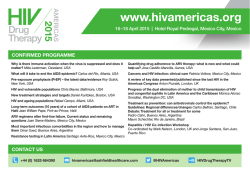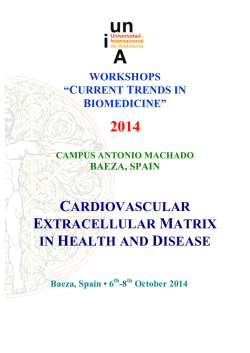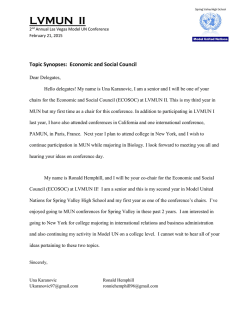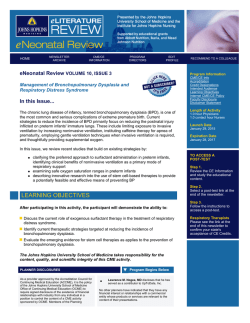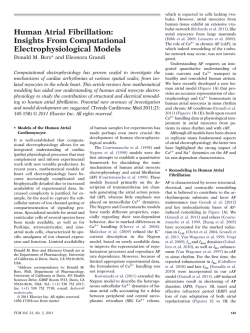
Download - eHIV Review
HOME CME INFORMATION PROGRAM DIRECTOR NEWSLETTER ARCHIVE EDIT PROFILE RECOMMEND TO A COLLEAGUE VOLUME 2 — ISSUE 8: TRANSCRIPT Featured Cases: HIV-Associated Cardiovascular Disease: An Update Our guest author is Thomas Metkus, MD, Fellow in Cardiovascular Medicine, at Johns Hopkins Hospital. After participating in this activity, the participant will demonstrate the ability to: n n n MEET THE AUTHOR Thomas Metkus, FIDSA Fellow in Cardiovascular Medicine Johns Hopkins Hospital Baltimore, Maryland Assess the risks for subclinical coronary plaque in HIV infected persons seen in the clinic. Discuss treatment strategies to mitigate HIV associated coronary risk. Diagnose and manage atrial arrhythmias associated with HIV. This discussion, offered as a downloadable audio file and companion transcript, covers the important topic of HIV-associated cardiovascular disease in the format of case-study scenarios for the clinical practice. This program is a follow up to the Volume 2, Issue 7 eHIV Review newsletter — HIV-Associated Cardiovascular Disease: An Update. Unlabeled/Unapproved Uses Dr. Metkus has indicated that there will be no references to unlabeled/unapproved uses of drugs or products. PROGRAM DIRECTORS Richard Moore, MD, MHS Professor of Medicine Director, Moore Clinic for HIV Care Divisions of Infectious Diseases and Clinical Pharmacology Johns Hopkins University School of Medicine Baltimore, Maryland Faculty Disclosure Dr. Metkus has indicated that he has no financial interests or relationships with any commercial entity whose products or services are relevant to the content of his presentation. Release Date January 29, 2015 Michael Melia, MD Assistant Professor of Medicine Associate Fellowship Program Director Division of Infectious Diseases Johns Hopkins University School of Medicine Baltimore, Maryland Expiration Date January 28, 2017 Jeanne Keruly, MS, CRNP Assistant Professor of Medicine Department of Medicine, Division of Infectious Diseases Director, Ryan White Ambulatory Services Johns Hopkins University School of Medicine Baltimore, Maryland ACCREDITATION STATEMENTS Physicians This activity has been planned and implemented in accordance with the Essential Areas and Policies of the Accreditation Council for Continuing Medical Education through the joint providership of the Johns Hopkins University School of Medicine and the Institute for Johns Hopkins Nursing. The Johns Hopkins University School of Medicine is accredited by the ACCME to provide continuing medical education for physicians. Nurses The Institute for Johns Hopkins Nursing and the American Nursing Credentialing Center do not endorse the use of any commercial products discussed or displayed in conjunction with this educational activity. CREDIT DESIGNATIONS Physicians eNewsletter: The Johns Hopkins University School of Medicine designates this enduring material for a maximum of 1.0 AMA PRA Category 1 Credit(s)™. Physicians should claim only the credit commensurate with the extent of their participation in the activity. Podcast: The Johns Hopkins University School of Medicine designates this enduring material for a maximum of 0.5 AMA PRA Category 1 Credit(s)™. Physicians should claim only the credit commensurate with the extent of their participation in the activity. Nurses eNewsletter: This 1 contact hour educational activity is provided by the Institute for Johns Hopkins Nursing. Each newsletter carries a maximum of 1 contact hour or a total of 6 contact hours for the six newsletters in this program. Podcast: This 0.5 contact hour educational activity is provided by the Institute for Johns Hopkins Nursing. Each podcast carries a maximum of 0.5 contact hours or a total of 3 contact hours for the six podcasts in this program. There are no fees or prerequisites for this activity. SUCCESSFUL COMPLETION To successfully complete this activity, participants must read the content, and then link to the Johns Hopkins University School of Medicine's website or the Institute for Johns Hopkins Nursing's website to complete the post-test and evaluation. A passing grade of 70% or higher on the post-test/evaluation is required to receive CE credit. LAUNCH DATE January 29, 2015; activities expire 2 years from the date of publication. Length of Activity: 30 minutes STATEMENT OF NEED n As the demographics of HIV have shifted to include many older adults, clinicians require education regarding the treatment of common comorbidities. n Clinicians may be unclear about issues specific to the diagnosis and treatment of women with HIV. n Many clinicians require education regarding current treatment and new emerging hepatitis C medications in patients coinfected with HIV/HCV who require antiretroviral therapy. n Clinicians may need an update on current recommendations for the treatment of HIV with HAART. INTERNET CME POLICY The Office of Continuing Medical Education (CME) at the Johns Hopkins University School of Medicine is committed to protecting the privacy of its members and customers. The Johns Hopkins University School of Medicine maintains its Internet site as an information resource and service for physicians, other health professionals, and the public. Continuing Medical Education at the Johns Hopkins University School of Medicine will keep your personal and credit information confidential when you participate in an Internet-based CME program. Your information will never be given to anyone outside of the Johns Hopkins University School of Medicine program. CME collects only the information necessary to provide you with the services that you request. To participate in additional CME activities presented by the Johns Hopkins University School of Medicine Continuing Medical Education Office, please visit www.hopkinscme.edu. DISCLAIMER STATEMENT The opinions and recommendations expressed by faculty and other experts whose input is included in this program are their own. This enduring material is produced for educational purposes only. Use of the Johns Hopkins University School of Medicine name implies review of educational format design and approach. Please review the complete prescribing information for specific drugs or combinations of drugs, including indications, contraindications, warnings, and adverse effects before administering pharmacologic therapy to patients. eHIV Review Podcast Transcript, Volume 2: Issue 8 PROGRAM BEGINS BELOW _ CME INFORMATION STATEMENT OF RESPONSIBILITY The Johns Hopkins University School of Medicine takes responsibility for the content, quality, and scientific integrity of this CME activity. INTENDED AUDIENCE The target audience (clinicians) for this initiative includes infectious disease (ID) specialists, primary care physicians (PCPs), nurse practitioners (NPs), physician assistants (Pas), and other health care practitioners whose work/practice includes treating patients with HIV. PLANNER DISCLOSURE As a provider approved by the Accreditation Council for Continuing Medical Education (ACCME), it is the policy of the Johns Hopkins University School of Medicine Office of Continuing Medical Education (OCME) to require signed disclosure of the existence of financial relationships with industry from any individual in a position to control the content of a CME activity sponsored by OCME. Members of the Planning Committee are required to disclose all relationships regardless of their relevance to the content of the activity. Faculty are required to disclose only those relationships that are relevant to their specific presentation. The following relationship has been reported for this activity: n Richard Moore, MD, MHS discloses that he has served as a consultant for Merck. n Michael Melia, MD discloses that he has received grants from Merck, Gilead, Bristol-Myers Squibb, Janssen and AbbVie. No other planners have indicated that they have any financial interest or relationships with a commercial entity whose products or services are relevant to the content of their presentation. Guest Author Disclosures CONFIDENTIALITY DISCLAIMER FOR CME CONFERENCE ATTENDEES I certify that I am attending a Johns Hopkins University School of Medicine CME activity for accredited training and/or educational purposes. I understand that while I am attending in this capacity, I may be exposed to “protected health information,” as that term is defined and used in Hopkins policies and in the federal HIPAA privacy regulations (the “Privacy Regulations”). Protected health information is information about a person’s health or treatment that identified the person. I pledge and agree to use and disclose any of this protected health information only for the training and/or educational purposes of my visit and to keep the information confidential. I agree not to post or discuss this protected health information, including pictures and/or videos, on any social media site (e.g. Facebook, Twitter, etc.), in any electronic messaging program or through any portable electronic device. I understand that I may direct to the Johns Hopkins Privacy Officer any questions I have about my obligations under this Confidentiality Pledge or under any of the Hopkins policies and procedures and applicable laws and regulations related to confidentiality. The contact information is: Johns Hopkins Privacy Officer, telephone: 410-735-6509, email [email protected]. “The Office of Continuing Medical Education at the Johns Hopkins University School of Medicine, as provider of this activity, has relayed information with the CME attendees/participants and certifies that the visitor is attending for training, education and/or observation purposes only.” For CME Questions, please contact the CME Office (410) 955-2959 or email [email protected]. For certificates, please call (410) 502-9634. Johns Hopkins University School of Medicine Office of Continuing Medical Education Turner 20/720 Rutland Avenue Baltimore, Maryland 21205-2195 Reviewed & Approved by: General Counsel, Johns Hopkins Medicine (4/1/03) (Updated 4/09 and 3/14) HARDWARE & SOFTWARE REQUIREMENTS Pentium 800 processor or greater, Windows 98/NT/2000/XP/7 or Mac OS 9/X, Microsoft Internet Explorer 5.5 or later, 56K or better modem, Windows Media Player 9.0 or later, 128 MB of RAM, sound card and speakers, Adobe Acrobat Reader, storage, Internet connectivity, and minimum connection speed. Monitor settings: High color at 800 x 600 pixels. eHIV REVIEW PODCAST TRANSCRIPT MR. BOB BUSKER: Welcome to this eHIV Review Podcast. Today’s program is a follow-up to our newsletter on HIV-Associated Cardiovascular Disease. With us today is one of that issue’s authors, Dr. Thomas Metkus, a fellow in cardiovascular medicine at Johns Hopkins Hospital in Baltimore, Maryland. eHIV Review is jointly presented by the Johns Hopkins University School of Medicine and the Institute for Johns Hopkins Nursing. This program is supported by educational grants from AbbVie, Inc., Merck & Co., and ViiV Healthcare Company. Learning objectives for this audio program include: n Assess the risks for subclinical coronary plaque in HIV-infected persons seen in the clinic. n Discuss treatment strategies to mitigate HIVn associated coronary risk. Diagnose and manage atrial arrhythmias associated with HIV. Dr. Metkus has indicated that he has no financial interests or relationships with any commercial entity whose products or services are relevant to the content of his presentation and that his discussion today will not reference the unlabeled or unapproved uses of any drugs or products. I’m Bob Busker, managing editor of eHIV Review. Dr. Metkus, thank you for joining us today. DR. THOMAS METKUS: It’s a pleasure to be here. Thanks for having me. MR. BUSKER: In your newsletter issue, Dr. Metkus, you — along with your co-authors Dr. Wendy Post and Dr. Todd Brown from Johns Hopkins — discussed new publications describing the increasing prevalence of heart disease in individuals with HIV infection. What I’d like to do today is discuss how some of that new information can be translated into practice change in the clinic. So if you would, doctor, start us out with a patient description. DR. METKUS: Our first patient is a 52 year old man who presents to the office for evaluation. He has HIV diagnosed nine years ago and is currently managed with tenofovir, lamivudine, and emtricitabine. His eHIV Review Podcast Transcript, Volume 2: Issue 8 medical history includes hypertension and obesity. He smokes one-half pack of cigarettes per day. He has no cardiovascular symptoms. The last viral load was undetectable, and the last CD4 T cell count was 782. MR. BUSKER: So an HIV-infected patient comes into your office — why should you be thinking about their cardiovascular risk? DR. METKUS: HIV infected patients are at higher risk for cardiovascular disease including specifically myocardial infarction, and this has been demonstrated in several large epidemiologic studies. In addition to an increased risk of cardiovascular events, there is a higher prevalence of subclinical coronary plaque assessed by CT angiography, or coronary calcium scoring, and other such techniques. Hence, the first important step in assessing an HIV infected patient is simply awareness of the increased cardiovascular risk which translates into taking steps to mitigate that risk. Patients can present at younger than typical ages, so for this relatively young patient at 52 years old, this is a prescient discussion. Patients with HIV have a high prevalence of traditional cardiovascular risk factors including hypertension, dyslipidemia, obesity and sedentary habits, poor diet, and tobacco use. These risk factors are not mitigated by HIV per se, but merit equal attention and treatment. HIV-related risk factors include poorly controlled disease, either at present or in the past; nadir CD4 count and increased viral load have both been associated with markers of coronary disease in some studies. The studies on specific antiretroviral therapy agents, including protease inhibitors, are mixed, and the effect of any one agent on cardiovascular outcomes, if present, is likely small. MR. BUSKER: How should cardiovascular risk be assessed in an HIV infected person? What’s the first thing to do? DR. METKUS: The first step in cardiovascular prevention, irrespective of whether a patient is HIV infected or HIV uninfected, includes an assessment of cardiovascular risk, which yields a 10 year likelihood of myocardial infarction or stroke. 1 Many tools can do this, ranging from the Framingham score to imaging studies. The recently developed and updated ACC/AHA Cardiovascular Prevention Guidelines advocate use of the pooled cohort equation, which includes as variables a patient’s age, gender, race, blood pressure, lipids, tobacco use, and diabetes. The equation outputs a 10-year risk. Whether this equation has similar utility in HIV infected persons as in the general population is not known, and this issue merits further study. The “DAD equation” has been published and adds exposure to abacavir, indinavir, and lopinavir to the traditional cardiovascular risk factors to assess risk in HIV infected persons. This equation needs further validation and is not included in the current cardiovascular prevention guidelines. MR. BUSKER: Now given that HIV infected persons do have a higher burden of subclinical cardiovascular disease — you talked about subclinical coronary plaque in your newsletter and you mentioned it earlier in this discussion — should atherosclerosis imaging with coronary calcium scans or CT angiography be routinely use in these patients? DR. METKUS: The current ACC/AHA guidelines suggest that atherosclerosis imaging be considered in an intermediate risk patient if the results would change management. So if an HIV infected person is low risk by traditional metrics, there are no data that support interval imaging; rather, a trial of lifestyle modification and optimization of the traditional risk factors, including with exercise and dietary intervention, would be warranted to start. If, on the other hand, a patient is at intermediate risk and would otherwise qualify for treatment, atherosclerosis imaging could be considered. Our group and others have shown that HIV infected persons have a high burden of noncalcified coronary plaque and, as such, the optimal technique for atherosclerosis imaging is not clear, but certainly routine use is not indicated. MR. BUSKER: For a patient like the one you’ve described for us, what first-line tests would be indicated? DR. METKUS: First-line testing should include a fasting lipid profile and a hemoglobin A1c, as well as a fasting glucose. One could also consider eHIV Review Podcast Transcript, Volume 2: Issue 8 measurement of waist circumference and body mass index. Given that he’s asymptomatic, there is certainly no indication for stress testing or other functional testing at present. Still, at each visit patients should be questioned in depth about the onset of cardiovascular symptoms, which can be subtle or minimized by patients in some circumstances. MR. BUSKER: Well, thank you, doctor. And we’ll return, with Dr. Thomas Metkus from Johns Hopkins Hospital, in just a moment. JEANNE KERULY: Hello. I’m Jeanne Keruly, assistant professor of medicine in the Division of Infectious Diseases at the Johns Hopkins University School of Medicine. I’m one of the program directors of eHIV Review. If you found us on iTunes or on the web, please be sure to subscribe. This podcast is part of Johns Hopkins eHIV Review, an educational program providing monthly activities certified for CME credit and nursing contact hours, with expert commentary and useful practice information for clinicians treating patients with HIV. By subscribing, you’ll receive eHIV literature review newsletters and practice-based podcasts like this one directly through your email. There are no fees to subscribe or to receive continuing education credit for these activities. For more information or to subscribe to receive our newsletters and podcasts without charge, please visit www.eHIVReview.org. Thank you. MR. BUSKER: Welcome back to this eHIV Review podcast. I’m Bob Busker, managing editor of the program. Our guest is Dr. Thomas Metkus, from Johns Hopkins Hospital. And our topic is “HIV Associated Cardiovascular Disease.” We’ve been talking about a 52 year old man with well-controlled HIV. Let’s stay with that patient for a little while longer, Dr. Metkus, and let me ask you to continue the discussion by reviewing his presentation for us again. DR. METKUS: This 52 year old man, as you mentioned, has well-controlled HIV, he’s an active smoker, and he has hypertension and obesity. We’ll say that the office blood pressure was 144/88 and that’s treated with chlorthalidone. We checked a hemoglobin A1c which returned at 6.4%, and a fasting 2 lipid profile which resulted as a total cholesterol of 240, an HDL cholesterol of 34, a calculated LDL cholesterol of 170, and a triglyceride level of 180, all mg/dL. MR. BUSKER: So based on these numbers, what would be this patient’s 10 year risk of MI or stroke? DR. METKUS: Using the pooled cohort equation, referenced in the recently updated ACC/AHA Prevention Guidelines and also available on the web, his 10 year risk of heart attack or stroke is 21%, approximately one in five. If the risk factors of hypertension, smoking, and dyslipidemia were well controlled, the risk would be 2.6%. These percentages can be valuable counseling tools for patients, many of whom don’t appreciate the magnitude of their future cardiovascular risk. It’s worth noting that this high risk may even be an underestimate, given that the hemoglobin A1c places him in the “prediabetes” category, which is not accounted for in the risk equation. His obesity and sedentary lifestyle are additive risks that are not accounted for in the model. Thus, in the office we should be aggressive about risk factor modification, and just as important, transmitting the magnitude of risk to the patient in a manner that he can understand well the issues at hand. MR. BUSKER: I want to pick up on the last thing you said: communicating future CV risk to the patient. How should this patient be counseled? DR. METKUS: I would start by emphasizing that HIV infected persons are at high risk for cardiovascular disease which makes it even more important to control all the traditional cardiovascular risk factors. I would start by commending him on his excellent HIV disease control, but use that point to emphasize that even patients with well-controlled disease can harbor subclinical heart disease, as some of the reviewed studies demonstrate. And once he understands the importance of risk factor modification, I’d start sequentially, because major lifestyle changes introduced all at once can be difficult for patients to sustain. I would start by assessing his willingness to quit smoking, to begin an exercise program, and to lose weight. If he has particular interest or motivation in any one of these areas, that might be a great area with which to begin. eHIV Review Podcast Transcript, Volume 2: Issue 8 MR. BUSKER: I think that brings us to a key question here. And that’s: how would you treat this patient? DR. METKUS: Addressing lifestyle factors is key, to start with. Smoking cessation is absolutely mandatory but is often among the most challenging points for patients to implement. Some studies have shown that a minority of HIV infected smokers are ever even counseled to quit by their care teams. From the clinician’s perspective, it is important not to become frustrated and to remain really persistently supportive of smoking cessation efforts, even when an initial attempt fails. Weight loss and an exercise program really go handin-hand. Some patients have had weight loss success using fitness trackers or nutritional apps for their smart phones, and this may be a good, novel approach if a patient is interested. Once patients begin exercising, they often go on to lose weight, and conversely, once patients lose weight, they become more amenable to exercise. Treating blood pressure and prediabetes is another important step, because both conditions may improve with smoking cessation, exercise, and weight loss. Given his obesity and hypertension, it would be reasonable to screen for obstructive sleep apnea as well. If the blood pressure remains elevated to greater than 140/90 mm Hg despite these measures, adding a second antihypertensive agent could be considered. The specific antihypertensive agent matters less than control of the blood pressure in this clinical circumstance, assuming drug-drug interactions with his antiretroviral therapy regimen are accounted for. Given his high risk, guidelines suggest that statin therapy be initiated. Given possible drug-drug interactions, this should be done with full participation of all the members of his health care team, including his infectious disease specialists; his primary care and cardiology providers, if they are involved; and his pharmacist. MR. BUSKER: Initiating statin therapy — which statins should be used and which ones should be avoided in HIV infected persons? DR. METKUS: The most common and concerning drug-drug interaction involves statins and inhibitors of the cytochrome P4503A4 system, including protease inhibitors. Serum levels of simvastatin and 3 lovastatin are markedly elevated with protease inhibitor coadministration, therefore simvastatin and lovastatin should not be used with protease inhibitors because of an increased risk of rhabdomyolysis. Atorvastatin levels are modestly boosted by concurrent protease inhibitor use, mandating a lower dose. Rosuvastatin can be used similarly. Pravastatin should be dose-adjusted downward when the antiretroviral regimen includes darunavir. Fluvastatin, as well as niacin and fibrates, can be used without dose adjustment. For this patient, who is not taking a protease inhibitor based regimen, a moderate dose of atorvastatin would be a reasonable choice. He should be seen at regular intervals to assess his progress and introduce additional measures for prevention as he achieves each sequential goal. And of course, interval development of cardiovascular symptoms should be fully addressed in detail as they arise. MR. BUSKER: Thank you, Dr. Metkus. Let me ask you to describe a different patient for us, if you would, please. DR. METKUS: This patient is a 75 year old Caucasian man with well-controlled HIV, hypertension, and chronic kidney disease with a baseline creatinine of 1.8. He presents for a follow-up visit describing intermittent palpitations that last for up to two to three hours at time and abate spontaneously. He says that episodes occur once or twice per week and are associated with fatigue and breathlessness. And electrocardiogram in the office demonstrates normal sinus rhythm with diffuse, nonspecific T wave flattening. MR. BUSKER: He’s got palpitations lasting two to three hours, they happen a couple of times a week, they’re accompanied by fatigue and breathlessness — what diagnosis do these symptoms most likely suggest? DR. METKUS: The symptom complex is pretty characteristic of cardiac dysrhythmia, and the first step in diagnosis would be symptom-arrhythmia correlation by capturing the purported symptoms using some sort of ambulatory ECG monitoring, possibly Holter monitoring or other techniques. eHIV Review Podcast Transcript, Volume 2: Issue 8 HIV patients have been demonstrated to have a higher risk of atrial fibrillation and atrial flutter as compared to uninfected historical control patients and this patient has many of the comorbid risk factors demonstrated to be synergistic with HIV-associated atrial arrhythmia, including specifically Caucasian ethnicity, age, chronic kidney disease, and hypertension. Other diagnostic possibilities in addition to cardiac arrhythmia include electrolyte disturbances, thyroid disease, and possibly underlying pulmonary disease, each of which could cause symptoms in isolation or in association with secondary cardiac arrhythmia. MR. BUSKER: What do we know about the mechanism that predisposes a patient with HIV to atrial arrhythmia? DR. METKUS: It turns out the mechanism of arrhythmogenicity is not entirely clear, and it’s an important area for further study. Increased systemic inflammation has been hypothesized to mitigate, in part, the predisposition to atherosclerosis. And we know that atherosclerosis and atrial arrhythmia share some pathophysiologic mechanisms in general, so the HIV-associated inflammation may be in part responsible for this predisposition to atrial arrhythmias. Subclinical HIV-associated structural heart disease may also play a role. In this newsletter issue, we reviewed a study of asymptomatic HIV subjects who underwent cardiac MRI. HIV infected subjects had higher than expected levels of intramyocardial fat, and this is a novel finding but could reflect an endorgan manifestation of altered lipid handling. In addition, HIV infected subjects had more myocardial scar which the authors of the study hypothesized relates to prior myocarditis. Both myocardial scar and intramyocardial lipid are hypothetical links between HIV, structural heart disease, and an arrhythmogenic substrate. Again, this is all speculative and further studies directed at pathobiologic mechanisms of arrhythmia in HIV infected persons are very necessary. MR. BUSKER: Now the treatment of a patient with arrhythmia who is HIV infected, how is that different from the treatment of a-fib and atrial flutter in the general population? 4 DR. METKUS: We’d start by saying that some assessment of cardiac structure and cardiac function, typically with a 2-D echocardiogram, would be necessary to stratify treatment. For example, if mitral stenosis were discovered, treatment would differ. The treatment guidelines noted below are for patients with “nonvalvular” atrial fibrillation, which specifically refers to patients without mitral valve disease. Other diagnostic tests to be considered are an assessment of thyroid function, consideration of the presence of obstructive sleep apnea, alcohol and substance use screening, and presence or absence of intrinsic lung disease, all in the right clinical setting. The principles of treatment of arrhythmia in HIV infected and HIV uninfected patients are similar. Pillars of treatment include stroke prevention and symptom control. First, regarding stroke prevention, the stroke risk can be calculated using risk scores, specifically the CHADS2VASC score, which predicts stroke risk using comorbid conditions including heart failure, hypertension, diabetes, prior stroke, other vascular disease, and a patient’s age. The “HASBLED” score can be calculated to assess the risk of bleeding. So the key is balancing stroke risk and bleeding risk in deciding an anticoagulation strategy. Generally, for low or normal bleeding risk patients, those with a CHADS2VASC score greater than 1 should be considered for systemic anticoagulation. Warfarin or any of the novel anticoagulants could be considered, although warfarin is typically preferred in the setting of renal dysfunction. The symptom status will help guide a rate control or a rhythm control strategy. Rate control can be performed with beta blockers as first line. Rhythm control strategy can include drugs such as sotalol, propafenone, or flecainide, or pulmonary vein isolation/atrial fibrillation ablation. Use of rhythm control drugs and ablation and the rate control versus rhythm control strategy should both be guided by consultation with an electrophysiologist. All new drug prescriptions should be reviewed with the infectious diseases team and the infectious diseases pharmacist to avoid drug-drug interaction. I’d emphasize that no specific clinical trials of management of atrial fibrillation or atrial flutter have been directed specifically at the HIV infected population and that these treatment strategies are eHIV Review Podcast Transcript, Volume 2: Issue 8 drawn from guidelines in the general population. However, given the propensity to arrhythmia in this patient population, future clinical trials could certainly be directed at that question. MR. BUSKER: Dr. Metkus, I want to thank you for bringing us today’s patients and for sharing your team’s input on their management. I’d like to talk about research now and ask you where you think the future of HIV-related CVD care might be heading. DR. METKUS: This is a challenging research issue, in part because the latency period between a given exposure — for example, acute HIV infection, a period of time when there is poorly controlled HIV, the use of a specific antiretroviral drug, the latency between that exposure and the appearance of heart disease — can be many years. So prospective studies and randomized controlled studies are challenging in that setting. Hence, I think some very important future studies will be actually well-designed, multicenter epidemiologic studies that can answer important questions without the challenges inherent in designing randomized controlled trials in this population. Clinically, I think HIV-related heart disease will become increasingly important, particularly worldwide. As antiretroviral therapy becomes more available, the global life expectancy of HIV infected patients will increase, which we could hypothesize will yield increasing numbers of patients exposed to nonHIV-related complications, including heart disease. Ongoing education and maintaining awareness of HIV-related heart disease will hopefully go a long way toward timely diagnosis, number one, and optimum treatment, number two, in both preventing disease and treating it after it becomes manifest. MR. BUSKER: Thank you for sharing those insights, doctor. Let’s wrap things up by reviewing the key points of today’s discussion in light of our learning objectives. So to begin: assessing the risks for subclinical coronary plaque in HIV infected persons. DR. METKUS: Our first case reviewed risk factors underlying the subclinical atherosclerosis associated with HIV. There are really two classes: the first is risk factors not associated with HIV, including his obesity, dyslipidemia, smoking, sedentary lifestyle, and the traditional cardiovascular risk factors; the second is 5 risk factors associated with HIV, including systemic inflammation, possibly exposure to certain antiretroviral drugs, and possibly prior nadir CD4 count and other risk factors associated with HIV disease. The pathogenesis includes increased systemic inflammation and the comorbid traditional risk factors, as I mentioned. We also discussed that the utility of atherosclerosis imaging for screening, and functional testing for symptoms depends on the clinical scenario. MR. BUSKER: And: treatment to mitigate HIV associated coronary risk. DR. METKUS: We discussed optimizing non-HIVassociated risk factors as a critical step in management of even HIV-associated CAD, and I’d emphasize that the risks and the benefits, and importantly the drug-drug interactions associated with therapy, must be closely attended to in considering dyslipidemia management, most particularly, statin therapy in this population. MR. BUSKER: Finally: diagnosing and managing atrial arrhythmias associated with HIV. DR. METKUS: We reviewed the risk factors for HIV- associated atrial fibrillation and atrial flutter, which include specifically Caucasian ethnicity, age, chronic kidney disease, and hypertension. Testing strategies for the HIV patient with atrial fibrillation include ECG monitoring for symptom/arrhythmia correlation, echocardiography to assess for structural heart disease, and an assessment of thyroid function. Treatment strategies include stroke prevention, which should be considered after the diagnosis is made. This includes risk assessment using the CHADS2-VASc score; and importantly, the decision between rate and rhythm control should be guided by patient symptoms. MR. BUSKER: Dr. Thomas Metkus from the Johns Hopkins Hospital, thank you for participating in this eHIV Review Podcast. DR. METKUS: I enjoyed our discussion very much. Thanks so much for having me. MR. BUSKER: To receive CME credit for this activity, please take the post-test at www.ehivreview.org/test. eHIV Review Podcast Transcript, Volume 2: Issue 8 This podcast is presented in conjunction with the eHIV Review Newsletter, a peer-reviewed literature review certified for CME/CE credit, emailed monthly to clinicians treating patients with HIV. This activity has been developed for infectious disease specialists, primary care physicians, nurse practitioners, physician assistants, and other health care practitioners whose work or practice includes treating patients with HIV. This activity has been planned and implemented in accordance with the Essential Areas and Policies of the Accreditation Council for Continuing Medical Education, through the joint sponsorship of the Johns Hopkins University School of Medicine and the Institute for Johns Hopkins Nursing. The Johns Hopkins University School of Medicine is accredited by the ACCME to provide continuing medical education for physicians. The Johns Hopkins University School of Medicine designates this enduring material for a maximum of 0.5 AMA PRA Category 1 Credit(s)™. Physicians should claim only the credit commensurate with the extent of their participation in this activity. The Institute for Johns Hopkins Nursing is accredited as a provider of continuing nursing education by the American Nurses Credentialing Center’s Commission on Accreditation. For nurses, this 0.5 contact hour Educational Activity is provided by the Institute for Johns Hopkins Nursing. Each podcast carries a maximum of 0.5 contact hour. This educational resource is provided without charge, but registration is required. To register to receive eHIV Review via email, please go to our website: www.ehivreview.org. The opinions and recommendations expressed by faculty and other experts whose input is included in this program are their own. This enduring material is produced for educational purposes only. Use of the names of the Johns Hopkins University School of Medicine and the Institute for Johns Hopkins Nursing implies review of educational format, design, and approach. Please review the complete prescribing information for specific drugs, 6 combinations of drugs, or use of medical equipment, including indication, contraindications, warnings, and adverse effects, before administering therapy to patients. eHIV Review is supported by educational grants from AbbVie, Merck & Co., Inc., and ViiV Healthcare. This program is copyright with all rights reserved, by the Johns Hopkins University School of Medicine and the Institute for Johns Hopkins Nursing. eHIV Review Podcast Transcript, Volume 2: Issue 8 7
© Copyright 2025
